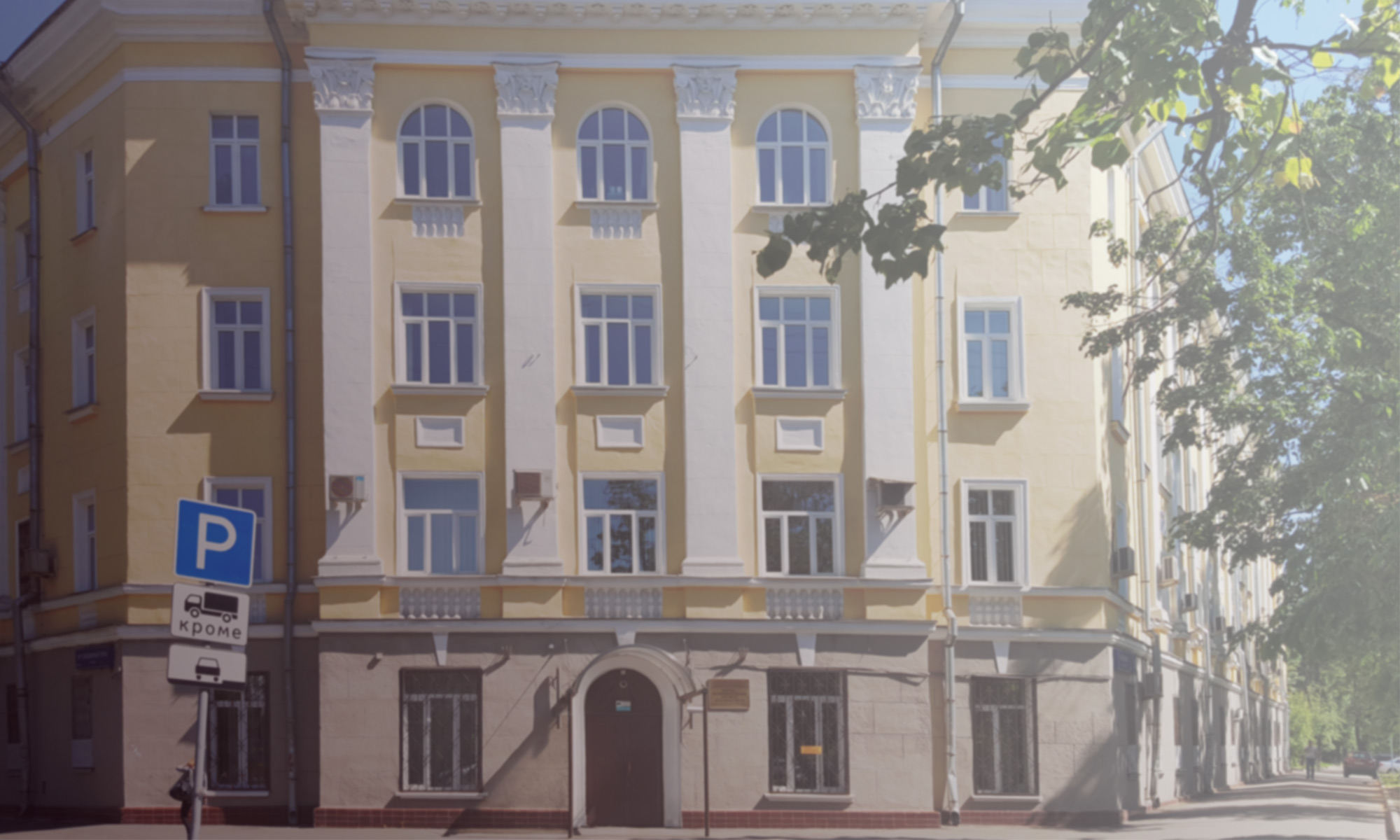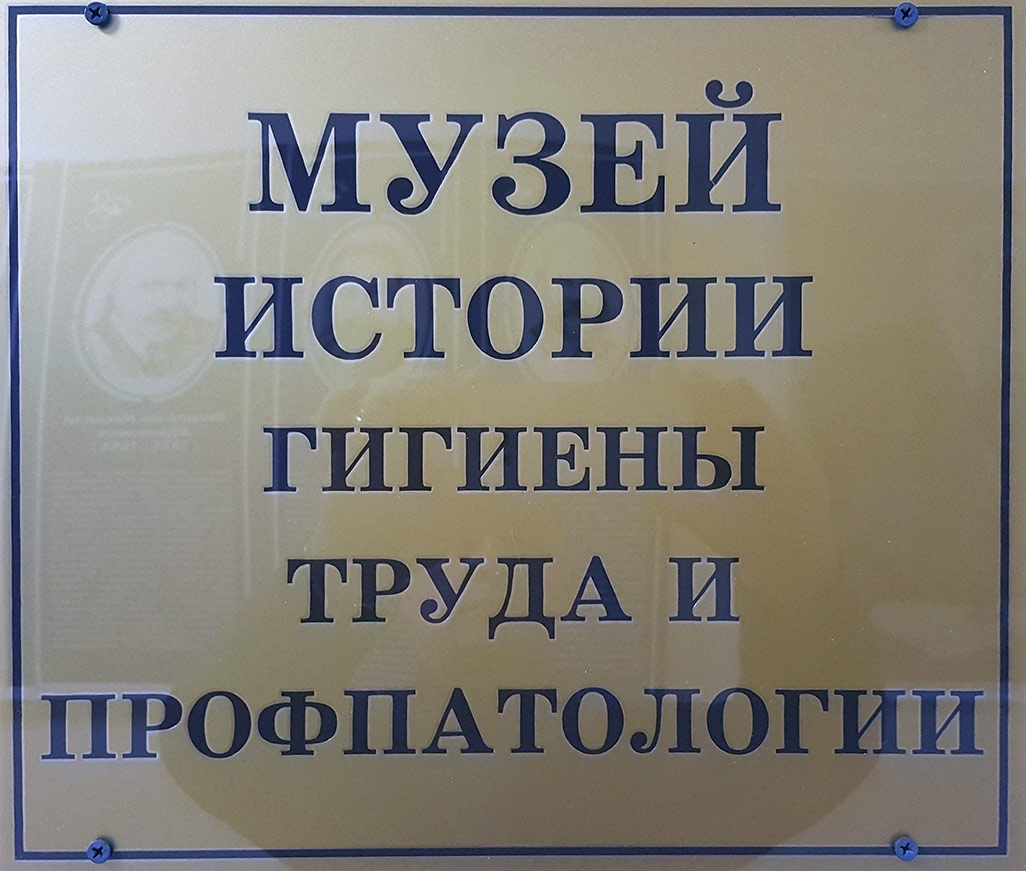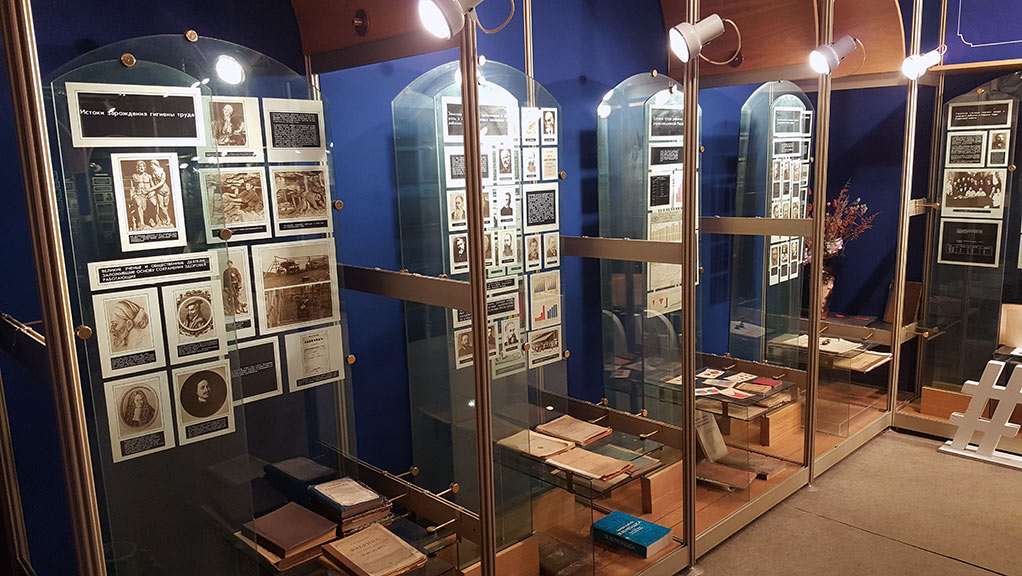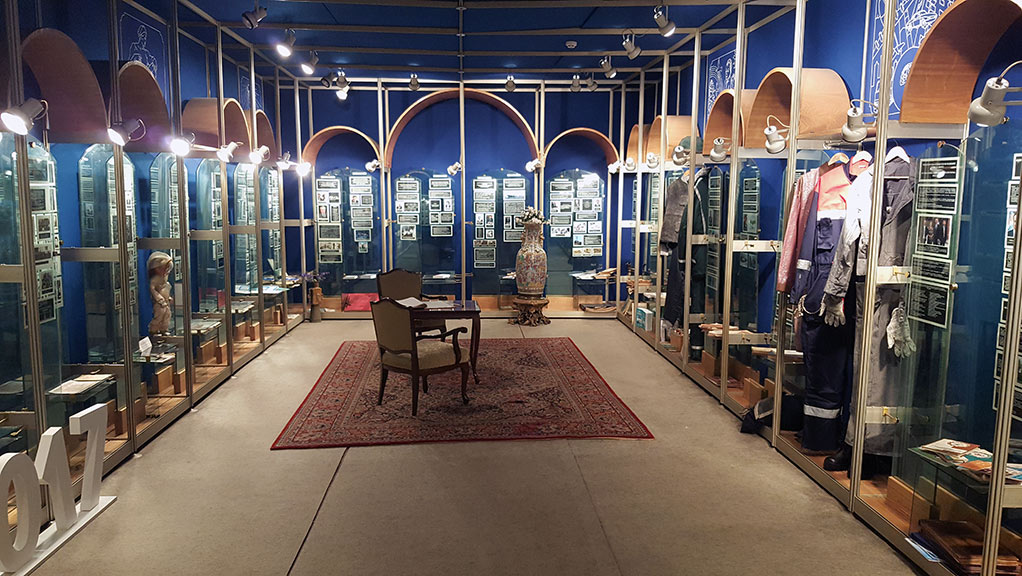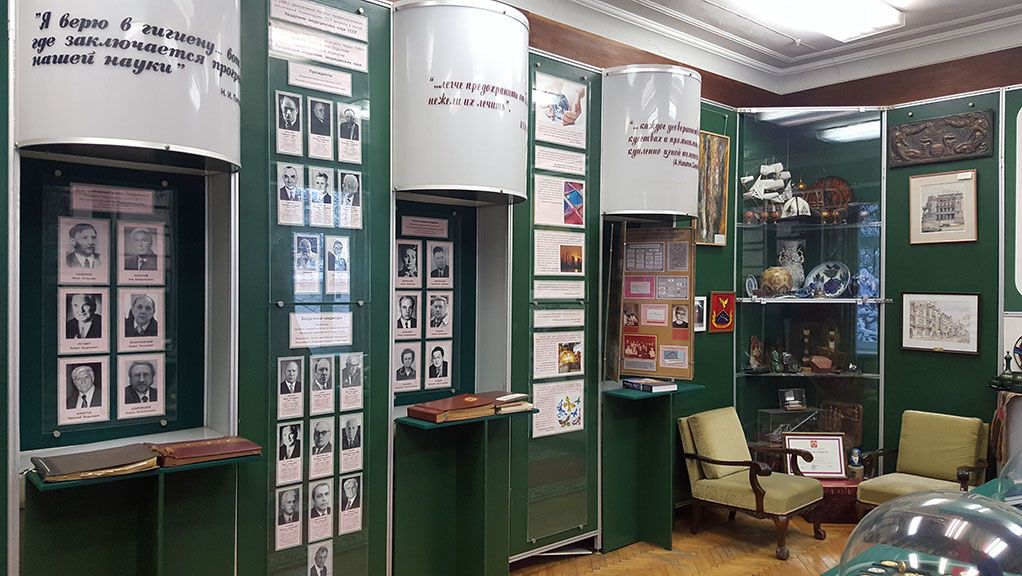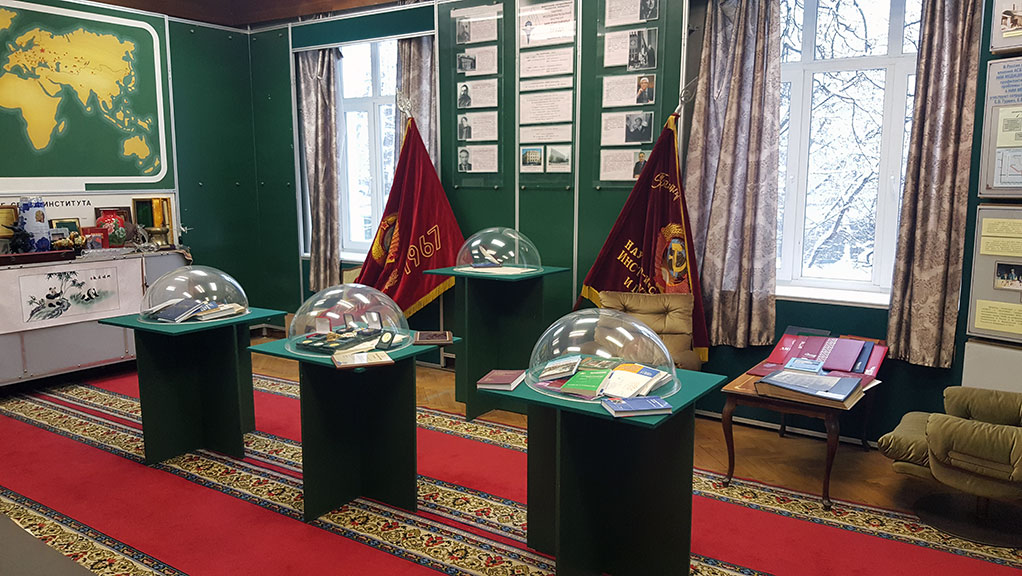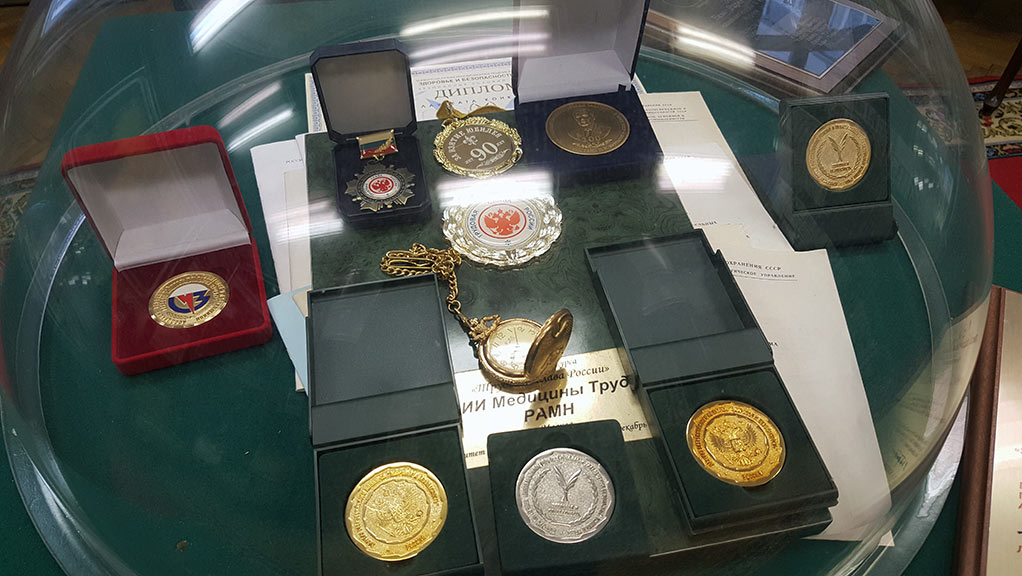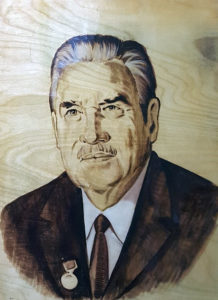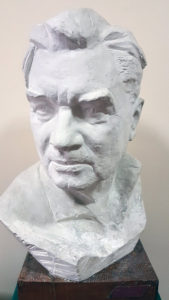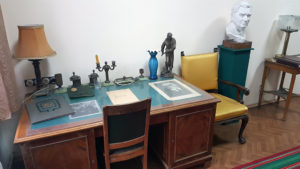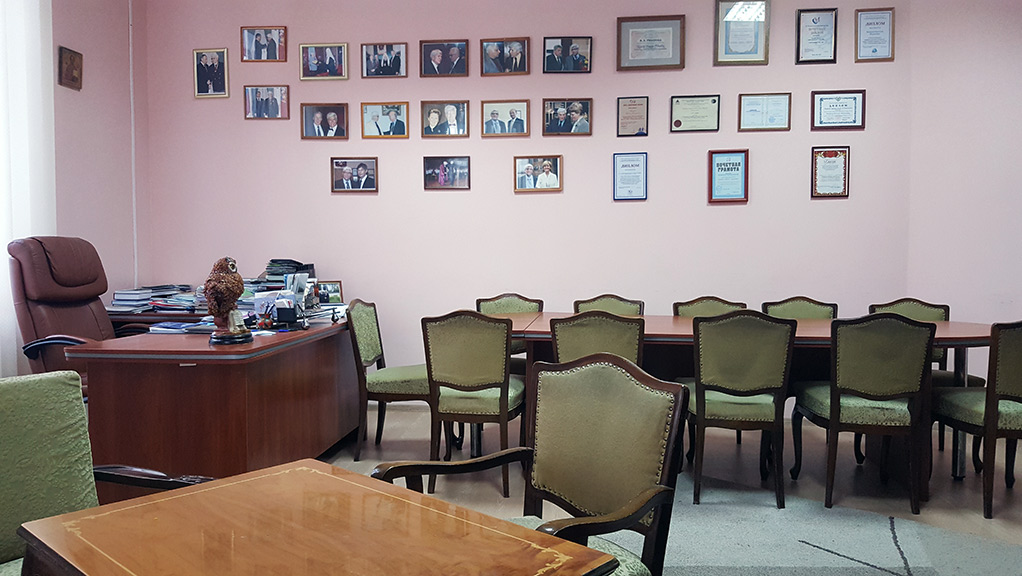Museum of the History of Occupational Health and Occupational Pathology
FSBSI “Izmerov Research Institute of Occupational Health”
In the Autumn of 1923, by decision of one of the first meetings of the Academic Council of the Institute the need to create a scientific library and museum was recognized. At the end of the same year, the “Science Museum” was opened.
The interest in the museum-exhibition exposition, reflecting the medical aspects of health’s maintaining in the workplace, appeared in the last quarter of the 19th century. It was in 1876 that the first international hygiene exhibition was held in Brussels. The Russian department successfully demonstrated the model of the school desk designed for schoolchildren by F.F. Erisman. It won the silver medal of the exhibition and was introduced into the production of factories of school and home furniture of almost all European countries with great enthusiasm.
At the International Hygiene Exhibitions in Dresden (1911) and Rotterdam (1928), pavilions, showing the latest means of production, paid at the same time great attention to working conditions: besides the means of protection, graphs, diagrams, tables with statistics of occupational injuries and occupational diseases in different branches of the extractive and manufacturing industries were presented.
In Russia the first hygienic exhibition was held a year earlier than in Europe. It was in 1875 in Saint-Petersburg. The following exhibition widely covered the problems of medicine and working and living conditions of workers of industries in the same place in St. Petersburg in 1889. Particularly valuable were the exhibits presented by the Riga Paper Factory (various technical plans, photographs, drawings, models of factory buildings), paper mill and weaving industries, coal and garden productions of Perm region, V.E. Morozov’s factories. All exhibits showed that already at that time the work on the study of air hygiene, the impact of air humidity, its composition and temperature on the employee was carried out.
First specialized exhibitions on occupational health and safety were held in 1884, 1893 and 1902. All of them were also held in St. Petersburg. After the victory of the Great October Revolution, the new government from the very first years of its existence took seriously the legislation, the regulatory framework and the propaganda of healthy work ideas and safety at work. Already in the Autumn of 1920 in Moscow the Week of Labor Protection was held. Its program included lectures, meetings, popular science seminars. The chronicle of the events was covered every day in the leading newspapers – the “Pravda” and the “Izvestia” newspapers, as well as the magazine “Bulletin of Agitation and Propaganda” of the Central Committee of the Russian Communist Party.
An important component of this event was an organized exhibition of mobile constructions, which later easily toured in many cities of Russia.
Professor of hygiene A.P. Dobroslavin wrote in one of his articles that “the exhibitions….give the possibility to monitor the progress or the decline of health care…”.
The first attempts to organize such permanent (stationary) institutions date back to the end of the 19th century. It was in 1897 that the Museum of Hygiene and Sanitary Engineering was established in Moscow and existed, however, only a few years. Besides that an interesting and voluminous exposition on labor safety issues was created in the same year at the Museum of the Mining Institute of St. Petersburg. It presented personal protective equipment for workers (clothes, glasses, masks, respirators, waterproof raincoats), diagrams and graphs of statistical data on accidents at mining enterprises of the industry, occupational injuries and occupational morbidity, many photos and drawings. The organizer of that exposition was a prominent public doctor D.P. Nikolsky.
The Museum of Occupational Hygiene and Social Economics (later renamed into the Social Museum named after A.V. Pogozhev) was engaged in serious propaganda of the theoretical and practical bases of occupational health and many aspects of accident prevention. The Museum was based on valuable collections of the famous sanitary doctor, publicist and statistics.
The Museum was created in the walls of the Faculty of Law of Moscow University in 1910 and was handed over in 1918 to the People’s Commissariat of Labor. Besides the exhibition, it included an extensive library with a huge collection of newspapers and magazines of the 19th century. In 1919 the Museum of Social Security and Labor Protection was formed based on the richest funds and exposition of the Social Museum named after A.V. Pogozhev and the Museum of the Moscow city hospital fund.
In addition, in 1919 the State Museum of Social Hygiene of the People’s Commissar of Health of the RSFSR was opened in Moscow. The organizer of the Museum was A.V. Molkov, the former head of the Pirogov Commission for the dissemination of hygienic knowledge to the public. For many years the employees of the Museum, which was located at the address – Novo-Basmannaya St., 18, gave lectures and conducted excursions on the occupational health issues. Only for the period of 1919-1922 the Museum was visited by more than 20.000 visitors, more then 60 % of them aged 21-30 years and by professionality – more then 50 % of the students.
N.A. Semashko, Z.P. Soloviev and A.N. Sysin paid much attention to the Museum personally. Later the Museum merged with the same Institute (now FSBSI “Science Research Institute for Public Health named after N.A. Semashko”) and its exposition existed in its walls until 1932.
By 1926 the Museums of occupational health and occupational diseases were opened in many large cities of Russia. Among them – Kharkov, Sverdlovsk, Leningrad, Samara, Saratov, Samarkand and others.
The second important Museum covering the occupational diseases’ issues and clinical and hygienic aspects, was the Museum organized at the Institute for the Study of Occupational Diseases named after V.I. Obukh.
Contemporaries called this Museum “the Pearl of the Institute” speaking of it in the following words: “One can not pass by the real treasure of the Institute, its museum…”. At the initiative of the first director of the Museum, sanitary doctor Y.U. Yanvel, since the moment it was opened, occupational hygiene and disease prevention classes for workers and students were constantly held there. The exposition of the Museum showed the results of the Institute’s work reflected in a number of posters, exhibits, diagrams, and emphasized the importance of scientific and practical activities of the world’s first scientific institution for a comprehensive study of occupational pathology.

Unfortunately, the use of the Museum as a visual educational supplement to the classes and seminars in the late 30s of the 20th century ceased, and after The Great Patriotic War, when the majority of the employees, including the directorate, returned back from evacuation to Moscow, the exposition was closed.
It is necessary to pay tribute to the director of the Institute of the third quarter of the 20th century A.A. Letavet. It was on his decision that all the materials and exhibits were carefully preserved in the Archives.
This fact allowed Nikolay Fedotovich Izmerov, the next Director of the Institute, renew the exhibition at the Institute in 1978 and restore the Museum, as well as to reorganize it technically and multiply it with new exhibits.

From the left to the right: E.I. Khukharina,L.K. Khotsyanov, Z.A. Volkova, L.S. Bogolepova, A.M. Rashevskaya, N.F. Izmerov, A.A.Letavet, E.I. Vorontsova, B.V. Shafranov, G.A. Beilikhis, M.N. Kogan, E.N. Marchenko, A.A. Kasparov, Y.M. Mirsky, V.M. Pobochin, V.D. Krainfeld.
Since 1987 this Museum is included in the “Catalog of Russian Museums” and is a member of the Association of Natural Sciences of Russia.
Now the Museum consists of several sections.
Portrait gallery of the glory of domestic specialists on the problems of occupational health and labor protection
This portrait gallery is a brief overview of the life and work of the largest domestic specialists in the field of occupational health and safety (21 personalities), covering the period from the end of the 19th century to the 70s of the 20th century.
Hall of History of occupational health and occupational pathology
The hall represents a vivid historical overview of the development of the problem of health preservation in the workplace in the world. Informational exhibits cover data on ancient and medieval scientists, researchers in Russia and Europe of subsequent centuries, the development of the preventive direction of medicine and, in particular, occupational health in scientific institutions in Russia and the post-Soviet space, educational institutions of the country, international specialized non-governmental organizations.
Hall of History of FSBSI “Izmerov Research Institute of Occupational Health”
This exposition tells about the history of our Institute from the first days of creation. From 1945 till 2012 the Institute was subordinate to the Academy of Medical Sciences of the USSR (later RAMS). The hall contains data on the Academy, its presidents and academicians-secretaries of the Department of Hygiene, Epidemiology and Microbiology (preventive medicine), directors and structure of the Institute, major historical events and directions of its activity. The hall also presents the main scientific works of the Institute, awards and certificates, gifts from cooperating institutions, colleagues and guests.
A.A. Letavet memorial room
This room is dedicated to the activities of the director of the Institute in 1948-1971, Laureate of the Lenin and State Prizes of the USSR, doctor of medical sciences, professor, the real member and academician secretary of the hygiene, microbiology and epidemiology department of the Academy of Medical Sciences of the USSR, the honored master of sports, the chairman of the mountaineering section “Science” and the member of the Presidium of the All-Union Mountaineering Federation August Andreevich Letavet. The cabinet was recreated using A.A. Letavet’s work and personal belongings (desk, writing instruments, personal library).
A significant part of the exposition is devoted to the climber’s life of the scientists, to which he devoted all his spare time from scientific activity. More than 20 expeditions to the Caucasian mountains, Pamir and Tien Shan, of which A.A. Letavet was the head of the group. At present time there are the Letavet Pass (4880 m) in the Peter I ridge and the Letavet Peak (6046 m), in which two saddles are distinguished.
February 6th, 2018 has marked the 125th anniversary of his birth..
The cabinet of N.F. Izmerov
The cabinet of Nikolai Fedorovich Izmerov, director of the Institute from 1972 to 2012 (more then 40 years), Chevalier of the Order of Merit for the Fatherland, IV, III and II degrees, the October Revolution and the Red Banner of Labor, Laureate of the RF Government Prize in Science and Technology, Honored Worker of Science of the Russian Federation, Doctor of Medical Sciences, Professor, Academician of the RAMS and the Russian Academy of Sciences.
Currently, the cabinet is used for meetings of the Directorate of the Institute, for meetings of the editorial board of the journal “Occupational Health and Industrial Ecology”, and for other solemn events.
The Museum in the only Museum in our country devoted to the problem of improving working conditions in industry and agriculture. The Museum exhibits unique books on occupational health and occupational diseases of the last three centuries, items of personal protective equipment and special uniform.
In the historical aspect, information materials on the achievements of scientific and technological progress and scientific institutions working on the problem of preserving the health of the working age population are presented. The Museum is of great interest for visiting scientists, the general medical community and scientific and technical staff working on the problem of occupational health.
The review is prepared by E.E. Shigan
